-
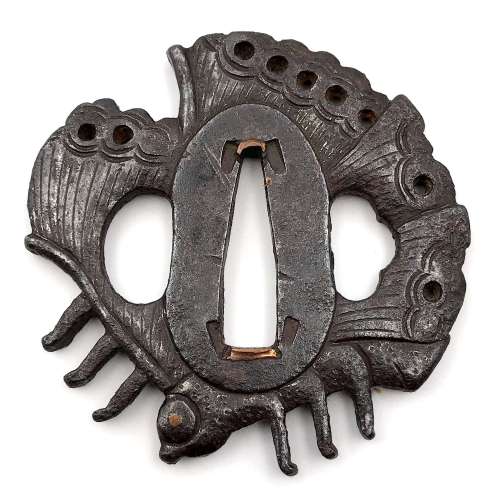 This tsuba is a cut from a typical Bizen Shōami butterfly tsuba (see TSU-0100 in this collection), which normally would have had a circular rim around the butterfly. In this particular example of altered guard we have both eyes of the insect (inlaid in brass or copper) intact. The kebori carving is more pronounced than in TSU-0100 example. Copper sekigane. Unsigned. Attributed to Bizen Shōami school, early Edo period (17th century). Dimensions: 64.7 x 63.7 x 5.2 mm References: see TSU-0100.
This tsuba is a cut from a typical Bizen Shōami butterfly tsuba (see TSU-0100 in this collection), which normally would have had a circular rim around the butterfly. In this particular example of altered guard we have both eyes of the insect (inlaid in brass or copper) intact. The kebori carving is more pronounced than in TSU-0100 example. Copper sekigane. Unsigned. Attributed to Bizen Shōami school, early Edo period (17th century). Dimensions: 64.7 x 63.7 x 5.2 mm References: see TSU-0100. -
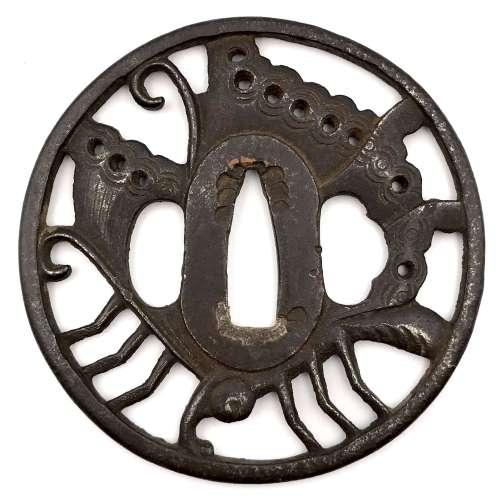 Iron tsuba of round form decorated with the design of a butterfly in openwork (sukashi) with details carved in kebori. Eyes inlaid in brass (one inlay is missing). Unsigned. Attributed to Bizen Shōami school, early Edo period (17th century). Dimensions: 80.4 x 80.6 x 4.4 mm References At Haynes Catalog #6, p. 18-19, Lot 30: "Famous Ikeda butterfly design" (Ikeda family of Inaba and Okayama, and at least 7 other families). Ca. 1700. Shōami of Kyoto, no doubt. Ht 8.2 cm, Th. 5 mm. ["Important tsuba, menuki, bokuto, woodblock prints, koshirae, sword pistol and kana mono". San Francisco, June 1-26, 1983. Catalog #6. Robert E. Haynes, Ltd.]Similar tsuba at Haynes Catalog #9, p.71, lot 143: the classic Shoami tsuba of the mon of the Ikeda family. This example, as most, seems to be made by the same hand as the others. See Haynes sale number 6, lot 30, for an identical example. The eye is brass. From an old French collection. Ht. 7.9 cm., Th. 5 mm.
Iron tsuba of round form decorated with the design of a butterfly in openwork (sukashi) with details carved in kebori. Eyes inlaid in brass (one inlay is missing). Unsigned. Attributed to Bizen Shōami school, early Edo period (17th century). Dimensions: 80.4 x 80.6 x 4.4 mm References At Haynes Catalog #6, p. 18-19, Lot 30: "Famous Ikeda butterfly design" (Ikeda family of Inaba and Okayama, and at least 7 other families). Ca. 1700. Shōami of Kyoto, no doubt. Ht 8.2 cm, Th. 5 mm. ["Important tsuba, menuki, bokuto, woodblock prints, koshirae, sword pistol and kana mono". San Francisco, June 1-26, 1983. Catalog #6. Robert E. Haynes, Ltd.]Similar tsuba at Haynes Catalog #9, p.71, lot 143: the classic Shoami tsuba of the mon of the Ikeda family. This example, as most, seems to be made by the same hand as the others. See Haynes sale number 6, lot 30, for an identical example. The eye is brass. From an old French collection. Ht. 7.9 cm., Th. 5 mm.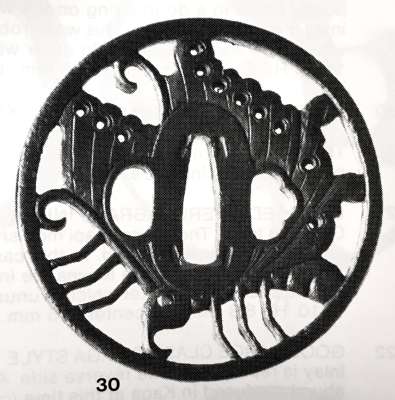
Haynes Catalog #6, lot 30.
Similar tsuba in the Randolph B. Caldwell Collection, 1994, page 24, №13: "A circular iron tsuba pierced in positive sukashi with a butterfly within an angular rim, details engraved. The eye inlaid in brass [in my specimen the inlay is missing on the omote side]. Unsigned. Bizen Shōami, Momoyama period. Dimensions: 8.0 x 8.2 x 0.5 cm. Similar example: Durand-Ruel, collection Ch. Gilloz, number 1302. [SV: that's possibly the 'old French collection' of Robert Haynes.]
Haynes Catalog #9, lot 143.
If we accept Haynes' theory regarding the genealogy and history of Bizen Shōami family, Momoyama period attribution would seem unlikely. I am leaning towards the early to mid 17th century.
Caldwell Collection, #13.
-

An iron tsuba of slightly vertically elongated circular form carved and pierced with a mass of ivy (tsuta) leaves and tendrils, details damascened with gold in nunome-zōgan technique. Hitsu-ana with raised rim.
Unsigned.
Chōshū school.Height: 72.0 mm; width: 69.0 mm; thickness: 4.7 mm; Weight: 92 g.
According to John W. Dower, "ivy bears fairly close resemblance to both maple leaf and grape leaf". However, I consider this tsuba decorated with ivy leaves for several reasons, such as the lack of racemations in the presence of tendrils. -
 Iron tsuba of a spindle shape (tate-itomaki-gata) pierced and inlaid in brass suemon-zōgan with bellflowers, vines and foliage, and a dragonfly in the upper right corner, on both sides. One of the hitsu-ana plugged with grey metal (led or pewter), nakaga-ana fitted with copper sekigane. The shape of the tsuba may be interpreted as four saddles connected to each other by horse bits. Such a design of sukashi and zōgan is usually attributed to Kaga Yoshirō branch of Heianjo school, active in the second half of the 17th century (c. 1650-1700). Size: 95.9 mm diagonal; 4.1 mm thickness. Tokubetsu Kicho certificate № 332 issued by NBTHK on October 12, 1965.
Iron tsuba of a spindle shape (tate-itomaki-gata) pierced and inlaid in brass suemon-zōgan with bellflowers, vines and foliage, and a dragonfly in the upper right corner, on both sides. One of the hitsu-ana plugged with grey metal (led or pewter), nakaga-ana fitted with copper sekigane. The shape of the tsuba may be interpreted as four saddles connected to each other by horse bits. Such a design of sukashi and zōgan is usually attributed to Kaga Yoshirō branch of Heianjo school, active in the second half of the 17th century (c. 1650-1700). Size: 95.9 mm diagonal; 4.1 mm thickness. Tokubetsu Kicho certificate № 332 issued by NBTHK on October 12, 1965. -

Iron tsuba of round form pierced (sukashi) in a chessboard fashion and decorated with linear (sen-zōgan) and cast (suemon-zōgan) brass inlay, including symbols of the swastika, flower-lozenge, maple leaf, pine needle, etc. on both sides; rim and openings outlined with brass inlay. Nakagō-ana plugged with copper fittings (sekigane).
Momoyama period. End of the 16th - beginning of the 17th century. Dimensions: Diameter: 75.5; Thickness: 4.5 mm. -
 Iron tsuba of almost round form with a brass outlined circular opening (sukashi) in the bottom adorned with the Myriad Treasures [takaramono, 宝物] and winter motifs inlaid in cast brass (suemon-zōgan); hitsu-ana possibly cut later, both plugged with shakudo, nakaga-ana fitted with copper sekigane. According to Merrily Baird*) (2001), the symbolism of Myriad Treasures “is associated with the Seven Gods of Good Luck, who carry them in a sack”. Among the treasures, which are said to ensure prosperity, long life, and general good fortunes, are (reading clockwise from the top):
Iron tsuba of almost round form with a brass outlined circular opening (sukashi) in the bottom adorned with the Myriad Treasures [takaramono, 宝物] and winter motifs inlaid in cast brass (suemon-zōgan); hitsu-ana possibly cut later, both plugged with shakudo, nakaga-ana fitted with copper sekigane. According to Merrily Baird*) (2001), the symbolism of Myriad Treasures “is associated with the Seven Gods of Good Luck, who carry them in a sack”. Among the treasures, which are said to ensure prosperity, long life, and general good fortunes, are (reading clockwise from the top):- Sake set [shuki, 酒器], namely flask, ladle, and cups
- Cloves [choji, 丁子]
- Purse of inexhaustible reaches [kinchaku, 巾着]
- Magic mallet [kozuchi, 小槌]
- Key to the storehouse of the Gods [kagi, 鍵]
- Rhombus, or Lozenge (hosho, 方勝), with the second ideograph meaning victory.
- Sacred (or wish-granting) gem, or jewel [hōju, 宝珠]
- Hats of invisibility [kakuregasa, 隠れ笠]
-

Thin iron tsuba of round form pierced with six three-leaf wood sorrels (katabami) in ko-sukashi and inlaid with brass decoration along the rim. Kozuka-hitsu-ana probably cut at a later date.
Late Muromachi or Momoyama period, 16th century. Dimensions: 78.0 x 77.7 x 2.5 mm. -

Iron tsuba of round form (tsurumaru) decorated with a design of crane and pines, or "nesting crane (sugomori-tsuru)" in openwork (sukashi). Details carved in kebori. Rounded rim.
Size: 74.7 x 69.8 x 4.8 mm.
Unsigned.
Edo period, ca. 17th century.
NBTHK Certificate № 463485. The certificate says it's a Higo School piece. The design was popular in both Akasaka and Higo schools. The Akasaka example: at Kodogu and tsuba. International collections not published in my books. (Toso Soran). Ph. D. Kazutaro Torigoye, 1978, p. 246: "Late Edo. Jiyūgata. Sined: Akasaka Tadanori saku."The Higo example can be found at Iron tsuba. The works of the exhibition "Kurogane no hana", The Japanese Sword Museum, 2014, p. 69, №56: Sugomori-tsuru sukashi-tsuba (Nesting Carne). Mumei: Matashichi (1st generation), early 17th century.
Torigoye, 1978, p. 246. Late Akasaka.

Kurogane no hana, 2014, p. 69, №56. Higo tsuba.
-

Iron tsuba of mokko form with rough surface decorated in low relief carving (sukidashi-bori) and openwork (sukashi) with a flying bat, a crescent moon, and a cloud over the moon. Bat's eyes inlaid with gold. Crescent moon and cloud on the reverse. Copper sekigane. Kogai hitsu-ana plugged with shakudō.
Unsigned.
Edo period.Size: Height: 83.7 mm; Width: 80.3 mm; Thickness: 2.9 mm; Weight: 141 g.
-
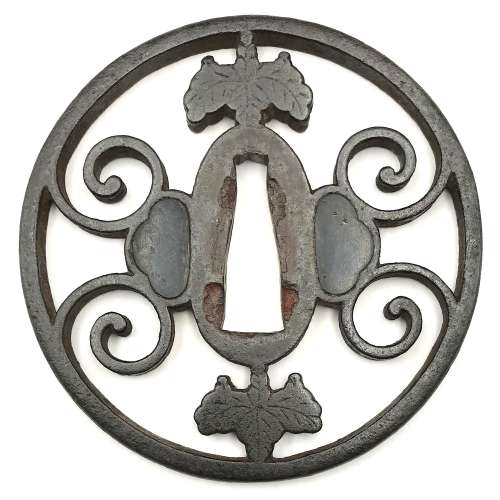
Iron tsuba of round form decorated with a design of bracken scrolls and paulownia leaves and blossoms (kiri-mon) in openwork (sukashi). Details carved in kebori. Squared rim with iron bones (tekkotsu). Hitsu-ana plugged with shakudō.
Size: 83.6 x 82.9 x 5.4 (center), 5.1 (rim) mm.
Unsigned.
Muromachi period, ca. 16th century.
-
 Iron tsuba of round form with a Marsilea (water clover, paddy plant, denjiso) in openwork (sukashi) and a cricket carved in low relief (katakiribori) with extremities and one antenna inlaid with brass; the other antenna is carved in kebori (which antenna is inlaid and which is carved alternates on the face and on the reverse). The plate decorated with vertical file stroke ornamentation (tate-yasurime). Raised dam-shaped rim (dote-mimi). Inscription from a previous collector in red oil paint: 22-71-1. Edo period, possibly 17th century. Katchushi school.
Iron tsuba of round form with a Marsilea (water clover, paddy plant, denjiso) in openwork (sukashi) and a cricket carved in low relief (katakiribori) with extremities and one antenna inlaid with brass; the other antenna is carved in kebori (which antenna is inlaid and which is carved alternates on the face and on the reverse). The plate decorated with vertical file stroke ornamentation (tate-yasurime). Raised dam-shaped rim (dote-mimi). Inscription from a previous collector in red oil paint: 22-71-1. Edo period, possibly 17th century. Katchushi school.Size: 75.0 x 74.4 x 3.6 (center), 5.0 (rim) mm.
The plant Marsilea (paddy plant, denjiso), common names include water clover and four-leaf clover because the long-stalked leaves have four clover-like lobes and are either held above water or submerged. In The elements of Japanese design by John W. Dower, this motif is listed under the numbers 634-35 Paddy Plant (denjiso). Obviously, as a four-leaf clover it is an auspicious symbol. The four leaves radiate out as the shape of the kanji 田 (romaji 'ta'), which means 'rice paddy'. This symbol may be used as a family crest (mon), and this would be the most probable explanation of the sukashi on this tsuba. -
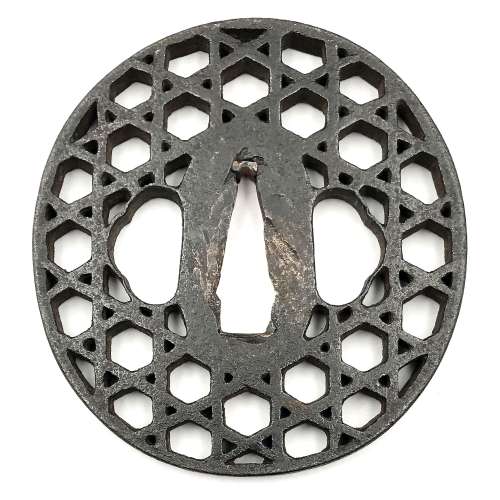
Iron tsuba of oval form decorated with design of jakago (bamboo lattice work) in openwork (sukashi). Copper sekigane.
Unsigned. Edo period.
Size: 73.7 x 70.3 x 5.6 mm.Note regarding design: though some might think that this piece belonged to a member of the lost tribe of Israel, it did not. Jakago baskets were made of bamboo, filled with rocks and used to catch crabs (besides other uses).
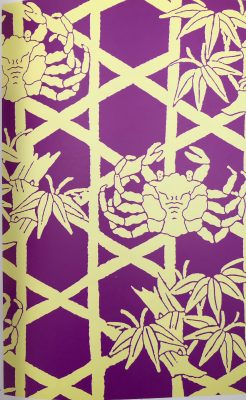
Jeanne Allen. Designer's Guide to Samurai Patterns. Chronicle Books, San Francisco, 1990; p.51, №57.
-
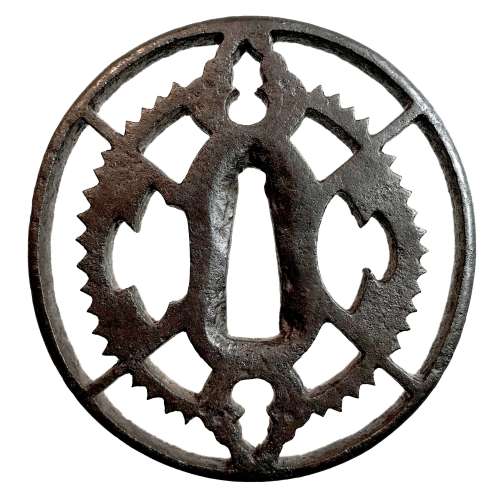
Iron tsuba of oval form pierced with design of slanting rays of light (shakoh), a Christian motif (Jesuit’s IHS symbol), and a pair of tassels in positive silhouette (ji-sukashi). Details on tassels carved in low relief. Traditional description of this kind of design is called “tokei”, or “clock gear”. Rounded rim.
Unsigned.
Edo period, 17th or 18th century. Possibly - Owari school.
Size: 76.0 x 73.0 x 6.2 mm. -
 Iron tsuba of oval form with design of a gourd or aubergine vine with fruits, leaves, and blossoms climbing a trellis, and a fence in yellow brass and red copper flat inlay (hira-zōgan); inlay engraved. Two latticed windows represented by openwork (sukashi). The iron web has deep black patina. The seller attributes this tsuba to Heianjo-Namban school, whatever it means. Momoyama or early Edo period, 17th century. Kaga or Heianjō School. Unsigned. Height: 77.3, Width: 73.1, Thickness at seppa-dai: 3.6 mm.
Iron tsuba of oval form with design of a gourd or aubergine vine with fruits, leaves, and blossoms climbing a trellis, and a fence in yellow brass and red copper flat inlay (hira-zōgan); inlay engraved. Two latticed windows represented by openwork (sukashi). The iron web has deep black patina. The seller attributes this tsuba to Heianjo-Namban school, whatever it means. Momoyama or early Edo period, 17th century. Kaga or Heianjō School. Unsigned. Height: 77.3, Width: 73.1, Thickness at seppa-dai: 3.6 mm. -

Iron tsuba of circular form with the knotted geese (kari) flying over the rough waves pierced (sukashi) and carved in low relief (nikubori). Hitsu-ana plugged with soft metal. Hitsu-ana plugged with soft metal (tin or lead).
Signed: Echizen koku jū Myochin Katsuharu saku.
Edo period.Size: Height: 80.7 mm; Width: 81.0 mm; Thickness: 4.5 mm; Weight: 110 g.
Two tsuba of this master can be found at Georg Oeder Collection (Japanische Stichblätter und Schwertzieraten. Sammlung Georg Oeder Düsseldorf. Beschreibendes Verzeichnis von P. Vautier. Herausgegeben von Otto Kümmel.Oesterheld & Co / Verlag / Berlin, Oesterheld, 1915; LIB-1465 in this collection) under №№ 172 and 173, page 21, though no illustrations. SOLD. -
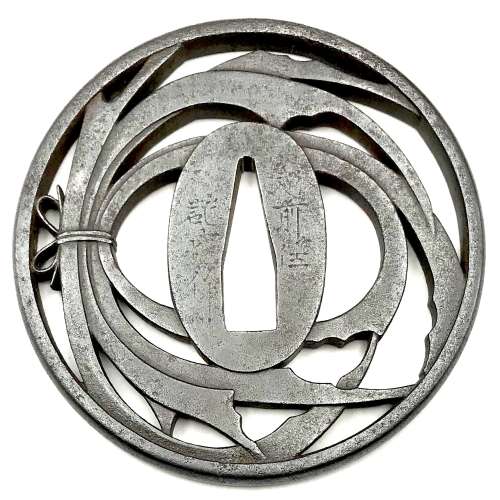
Iron tsuba of round form pierced (sukashi) and carved (marubori) with a 'noshi' decoration design. Noshi - decoration made of dried abalone (awabi) and bearing an auspicious connotation of good fortune, prosperity, etc. Design was used as a family crest (mon).
Size: 76.3 x 75.9 x 5.5 mm.
Signed: Echizen jū Kinai Saku. Kinai school existed from mid 17th to mid 19th century; it is hard to tell which master (generation from 1 to 6) made this particular piece.
SOLD -
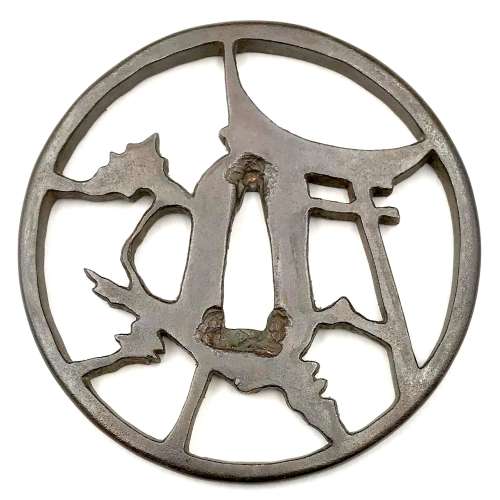
Iron tsuba of round form decorated with the design of distant pines, torii, and crescent moon in openwork (sukashi). Copper sekigane.
Size: 84.9 x 84.8 x 5.8 mm.
Unsigned.
Edo period, ca. 1750.
Tosa Myochin or Akasaka school.Japanese Swords and Sword Fittings from the Collection of Dr. Walter Ames Compton (Part I). Christie's, New York, March 31, 1992, pp. 28-29, № 53:
"A Tosa Myochin School Tsuba. Edo period (circa 1750), signed Toshu ju Kuniyoshi saku. The round iron plate pierced with a design of a temple gate (torii) and a pine tree. It has a round rim and there are some carved details on the surface of the design. The Tosa Myochin school, despite its foundation in the classic Myochin armor school tradition, worked mainly in the style of Akasaka school of Edo. [...] Many are equal to the mid to later Akasaka school work and the two types have frequently been confused. Signed examples are rare. Estimated price $1,500-2,000."
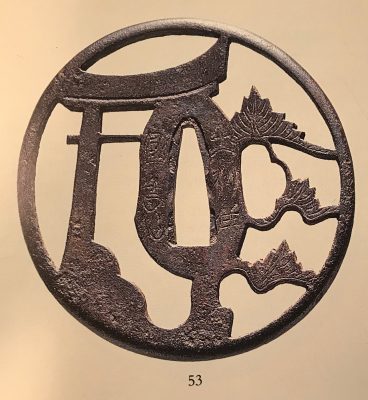
Compton Collection, Vol. 1, №53
-
 Iron tsuba of round form pierced with design of paulownia (kiri) in a circle in positive silhouette (ji-sukashi), details carved in low relief (sukidashi-bori). Hitsu-ana were cut later and then both plugged with lead or pewter. Brown patina. The most unusual characteristic of this tsuba is its 'positiveness': the absolute majority of Kamakura-bori tsuba are of ko-sukashi type, i.e. with small openings, presenting the motif in negative silhouette. Kamakura-bori school. Muromachi period (ca. 1450). Size: Height: 85.1 mm, width: 84.8 mm, thickness at seppa-dai: 3.2 mm, at rim: 2.8 mm. Weight: 79.1 g. A similar tsuba is presented at Japanese Swords and Sword Fittings from the Collection of Dr. Walter Ames Compton. Part I. Christie's, New York, March 31, 1992, page 11, №3: "A Kamakura-bori tsuba. Muromachi period, ca. 1450. The round iron plate is pierced with an openwork design of a paulownia crest (kiri-mon), the surface details of which are carved in low relief. The design is repeated on the reverse. The edge is slightly raised and the rim has some iron bones. 78 mm x 77 mm x 3.5 mm. Hakogaki by Sato Kanzan, dated summer 1973."
Iron tsuba of round form pierced with design of paulownia (kiri) in a circle in positive silhouette (ji-sukashi), details carved in low relief (sukidashi-bori). Hitsu-ana were cut later and then both plugged with lead or pewter. Brown patina. The most unusual characteristic of this tsuba is its 'positiveness': the absolute majority of Kamakura-bori tsuba are of ko-sukashi type, i.e. with small openings, presenting the motif in negative silhouette. Kamakura-bori school. Muromachi period (ca. 1450). Size: Height: 85.1 mm, width: 84.8 mm, thickness at seppa-dai: 3.2 mm, at rim: 2.8 mm. Weight: 79.1 g. A similar tsuba is presented at Japanese Swords and Sword Fittings from the Collection of Dr. Walter Ames Compton. Part I. Christie's, New York, March 31, 1992, page 11, №3: "A Kamakura-bori tsuba. Muromachi period, ca. 1450. The round iron plate is pierced with an openwork design of a paulownia crest (kiri-mon), the surface details of which are carved in low relief. The design is repeated on the reverse. The edge is slightly raised and the rim has some iron bones. 78 mm x 77 mm x 3.5 mm. Hakogaki by Sato Kanzan, dated summer 1973."
Compton's Collection, Part I, p. 11, №3.


